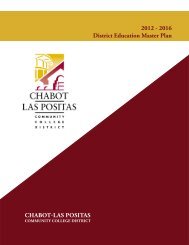City College of San Francisco - California Competes
City College of San Francisco - California Competes
City College of San Francisco - California Competes
Create successful ePaper yourself
Turn your PDF publications into a flip-book with our unique Google optimized e-Paper software.
THEME IV<br />
Collaboration has allowed the Department to leverage the resources they do have to maximum benefit.<br />
Participation in the Design Collaborative, a partnership with four other departments, is an obvious plus<br />
for a department that has suffered from many problems related to its small size. The Collaborative allows<br />
participating departments and programs (Architecture, Art, Graphic Communications, Multimedia Studies,<br />
and Photography) to achieve what one department acting alone would not be able to do. For example, the<br />
Collaborative has created Design courses that address the needs <strong>of</strong> students in participating departments.<br />
The Architecture Department’s collaboration goes beyond participation in the Design Collaborative.<br />
Collaborating with Engineering, Architecture can now <strong>of</strong>fer drafting classes several hours a day in a<br />
much more user-friendly Engineering Department lab. This enables them to remove the drafting tables<br />
from the CAD lab and turn it into a fully functional technology lab. In addition, their collaboration with<br />
Multimedia Studies has enabled Architecture to use the s<strong>of</strong>tware from that program while letting them<br />
use ARCH hardware. This exchange gives ARCH students a chance to learn 3-D modeling and animation.<br />
Multimedia, in turn, has waived a class pre-requisite for Architecture students, recognizing that they have<br />
acquired equivalent skills.<br />
Supporting learning. The many collaborations have greatly supported student learning. In fact, student<br />
success was cited by the Department Chair as an overarching departmental goal. One <strong>of</strong> the most important<br />
current initiatives has been a transfer and articulation guide. The new guide is seen as essential in<br />
helping students (especially the limited-English-speaking) navigate the seemingly mysterious labyrinth<br />
<strong>of</strong> procedures leading to transfer.<br />
In order to improve learning, the Department has taken steps to make facilities more useful. Many <strong>of</strong><br />
these modifications required no funding. One strategy was to open up spaces to new functions; for<br />
example, converting storage areas to pin-up space, so that student work could be critiqued; creating<br />
private spaces where faculty could confer in confidentiality with students; and setting aside large work<br />
areas for part-time faculty to grade student work. Thoughtful redesign and redeployment have supplemented<br />
available funding as a way <strong>of</strong> achieving goals. Much <strong>of</strong> the facilities redesign occurred as part <strong>of</strong><br />
the process <strong>of</strong> Program Review. The Program Review Committee was struck by the large number <strong>of</strong> basic<br />
facilities needs in the document. The Associate Vice Chancellor for Facilities was invited to a meeting<br />
with the Committee and the Department Chair. Ultimately, these individuals cooperatively established<br />
a structure for meeting facilities goals and committed to their achievement.<br />
In other instances, there may be budgetary constraints that do not lend themselves to mitigation<br />
through creativity or alternative funding. A major funding disappointment for Architecture has been<br />
the lack <strong>of</strong> funding for classified staff. In terms <strong>of</strong> serving students, a significant problem has been that<br />
the Department <strong>of</strong>fice is <strong>of</strong>ten not staffed. The other funding disappointment for the Department has<br />
been that only $500 a year is available for all supplies. All CCSF departments are struggling with similar<br />
limitations due to statewide cutbacks in recent years.<br />
Evaluation <strong>of</strong> the degree to which the Department’s goals have been met will be included in the next<br />
Program Review, just as the current one started with an assessment <strong>of</strong> what had been accomplished from<br />
the previous review. Departmental achievements will be summarized in Mid-Year and End-<strong>of</strong>-Year<br />
Assessment Reports.<br />
ESL Promotion Testing – Fine Tuning the Assessment Process. The evaluation that was conducted in<br />
Fall 2004 <strong>of</strong> noncredit ESL promotion testing forms the basis <strong>of</strong> this case, which was selected because it<br />
addresses student learning issues at the <strong>College</strong> within a noncredit context.<br />
304 CITY COLLEGE OF SAN FRANCISCO







